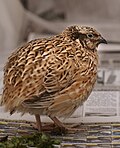| Coturnix | |
|---|---|
 | |
| Harlequin quail, C. delegorguei | |
| Scientific classification | |
| Kingdom: | Animalia |
| Phylum: | Chordata |
| Class: | Aves |
| Order: | Galliformes |
| Family: | Phasianidae |
| Subfamily: | Phasianinae |
| Tribe: | Coturnicini |
| Genus: | Coturnix Garsault, 1764 |
| Type species | |
| Tetrao coturnix Linnaeus, 1758 | |
| Species | |
See text | |
Coturnix is a genus of five extant species and five to eight known extinct species of Old World quail. [1]











